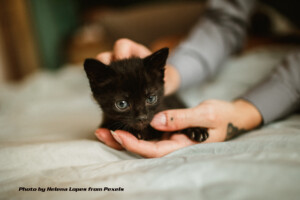Owning and interacting with pets, according to studies, is a form of therapy for many. We have dedicated Saturday to dogs and Wednesday to cats, when we will post an article on each of those days. We will also post articles on occasion about other animals people may have as pets. – Editorial Team
How To Take Care of Your New Kitten

The first step toward having a good pet cat is choosing a healthy kitten. Visit a litter of kittens about two weeks before they are ready to leave their mother. They will be six weeks old. Ask permission to pick up the kittens and be very gentle when to do so. Make sure that a kitten has clear, bright eyes and a shiny, full coat. Check the skin under the fur for any problems such as sores, rashes or bald spots. You want to choose a kitten that has healthy skin.
Next, make sure that the kitten is neither too thin nor too fat. A kitten that is either all skin and bones or has a bloated belly is likely to have an infection. Do not select such a kitten. Also check the kitten’s nose and ears for any sign of discharge or infection.
While you are checking for signs of physical health, take note of the kitten’s temperament. Carry the kitten to another part of the room and watch how it behaves. Is it nervous or scared? Does it respond to gentle petting by growing calmer? You want a kitten that adjusts quickly to you. This is a sign it has been handled by the owners of the litter, which is important in preparing the kitten for living with people.
It is extremely important to start out with a friendly cat. A scratching, hissing or terribly frightened kitten will grow up to be a difficult cat at best. At worst, the kitten will never become a friendly, loving pet.
After you have chosen a kitten that you like, make arrangements to pick it up when it is ready to leave its mother (when it is about eight weeks old). A day or two after you get your new kitten, take it to a veterinarian (an animal doctor). The vet will give it the first in a series of shots to protect it against common cat diseases. Tell the vet if you intend to let the cat outdoors. If you do intend to let it out, the kitten may need a shot to protect it against rabies.
The vet will also examine the kitten for signs of disease. Bring along sample of the kitten’s dropping so that the doctor can check for worms.
If the vet gives you medicine for the kitten, make sure that you or one of your parents understands how to give medicine. Ask the vet or the vet’s assistant to show the proper method. Give the medicine to the kitten exactly as directed by the vet. Twice a day is not good enough if the kitten is supposed to get medicine three times a day.
Young kittens like to eat every few hours, about four times a day. At each meal, serve a saucer of fresh milk alongside a small dish of dry cat food. For one or two of the meals, mix in canned food (meat or fish). If the kitten gets diarrhea, switch to powdered milk. If the diarrhea continues, reduce the amount of milk and the number of meals at which it is served.
Kittens love occasional treats, such as fresh liver, kidney or cottage cheese. But dry cat food is the best thing for a steady diet. Keep treats to once or twice a week.
As the kitten grows older, you can gradually reduce the number of meals. At six months, two meals each day are adequate. At one year, one meal a day is all that is needed. If your cat pesters you for a second meal, give a little more than half of the one-meal portion twice a day. The size of portions is usually recommended on the cat food box.
For your new kitten, and later your adult cat, keep a bowl filled with fresh water all times.
Although your kitten will decide for itself where it will sleep, it might enjoy a soft, snug spot you prepare for it. A fluffy, clean hand towel folded and placed in a shoe box that sits on its side, could make an attractive bed for your kitten. But the kitten may just decide to perch itself on a chair instead.
Although your kitten will decide for itself where it will sleep, it might enjoy a soft, snug spot you prepare for it. A fluffy, clean hand towel folded and placed in a shoe box that sits on its side, could make an attractive bed for your kitten. But the kitten may just decide to perch itself on a chair instead.
You will have to help your kitten get used to using a litter box to go to the bathroom. Getting your cat used to a litter box is usually easy, because cats are naturally clean and like to bury their droppings. A litter box is nothing more than a shallow rectangular container. The easiest kind to use is made of soft plastic. Into this you pour cat litter, which is sold in stores. Cover the bottom of the litter box with about two inches of cat litter.
Take your kitten to its litter box as soon you bring it home. Sometimes that first visit is all is needed. But until you are sure that the kitten understands, take it there after each feeding.
Sometimes cats will not use a litter box if something about the particular brand of litter is not to their liking. Occasionally they will avoid the box if its location is not private enough. Try to solve these problems if the kitten does not use the litter box from the start.
Sometimes cats will not use a litter box if something about the particular brand of litter is not to their liking. Occasionally they will avoid the box if its location is not private enough. Try to solve these problems if the kitten does not use the litter box from the start.
About the only unpleasant task involved in owning a cat is cleaning the litter box every two or three days. If you do not clean it, the box will begin to smell.
Empty all the used litter into a paper or plastic bag and take it outside to the garbage. Then wash the litter box with soap and water. Put the newly filled box back in the same place, so that you do not upset your cat’s routine.
If you plan on allowing your cat to go to outside, you may decide to let it go to bathroom outdoors. In this case, do not provide a litter box. Instead, take your new kitten outdoors to a spot where there is a patch of dirt in which it can dig and burry. After a few days, the kitten will wait by the door to be let out. Some people even install little cat doors so that their pets can come and go as they please.
An outdoor cat should wear a collar with an identification tag on it. The tag should give that cat’s name as well as your name and address.
Now that you know how to make your kitten feel welcome in its new home, it is time for you and your kitten to get to know one another.
Photo by Helena Lopes from Pexels
Pet Article courtesy of http://pet-articles.blogspot.com.

